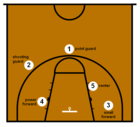Backcourt
In the sport of basketball , the positions of point guard and shooting guard are collectively referred to as the backcourt . The counterpart is the front court .
The division of the development players into a point guard and a shooting guard is a more recent invention. Originally, the two guards - as well as the two forwards - were entrusted with the same tasks, namely bringing the ball forward from the backcourt (their own half of the game) and starting plays there. As the two guards usually outside the three-point line , so act relatively far away from the basket, they are called collectively the backcourt (as opposed to the frontcourt of center and forwards). Players who can take both positions in their current form at a comparable level and are deployed accordingly are also known unofficially as combo guards .
The name Guard comes from the time the sport of basketball was created, when players - as in football - were divided into attackers (forwards) and defenders (guards). But after a short time it turned out that all five field players would be involved in both attack and defense. The introduction of the center line in 1932 and the associated ban on the second leg reinforced this development. The abolition of the jump ball after every basketball success (instead there is a throw-in under your basket) in 1937 allowed the guards to specialize in fast ball presentation and thus the structure of the game. When Basketball in the 1930s came to Germany, hence the name was point guard .
|
||||||||||||||||||||||
Individual evidence
- ↑ Definition of backcourt . Retrieved February 16, 2015.
